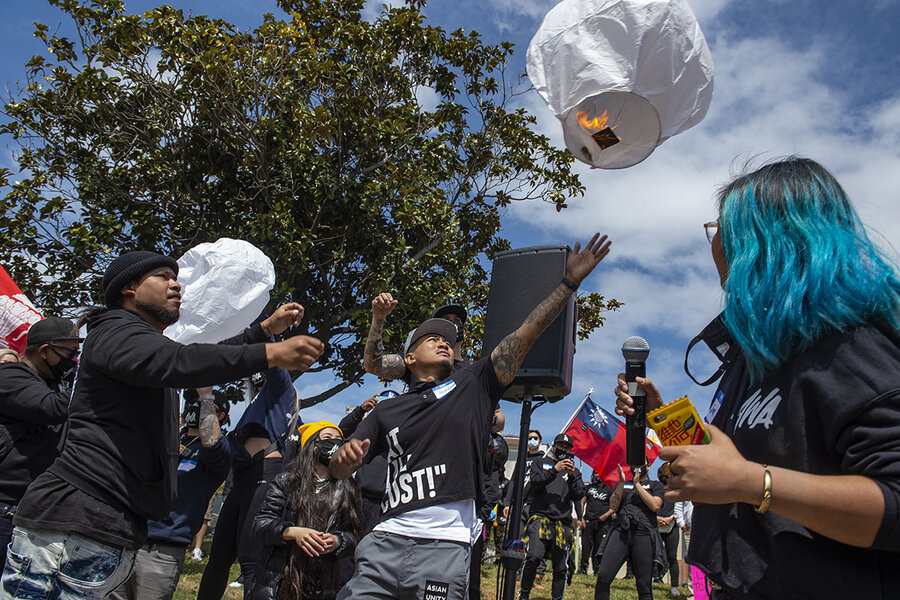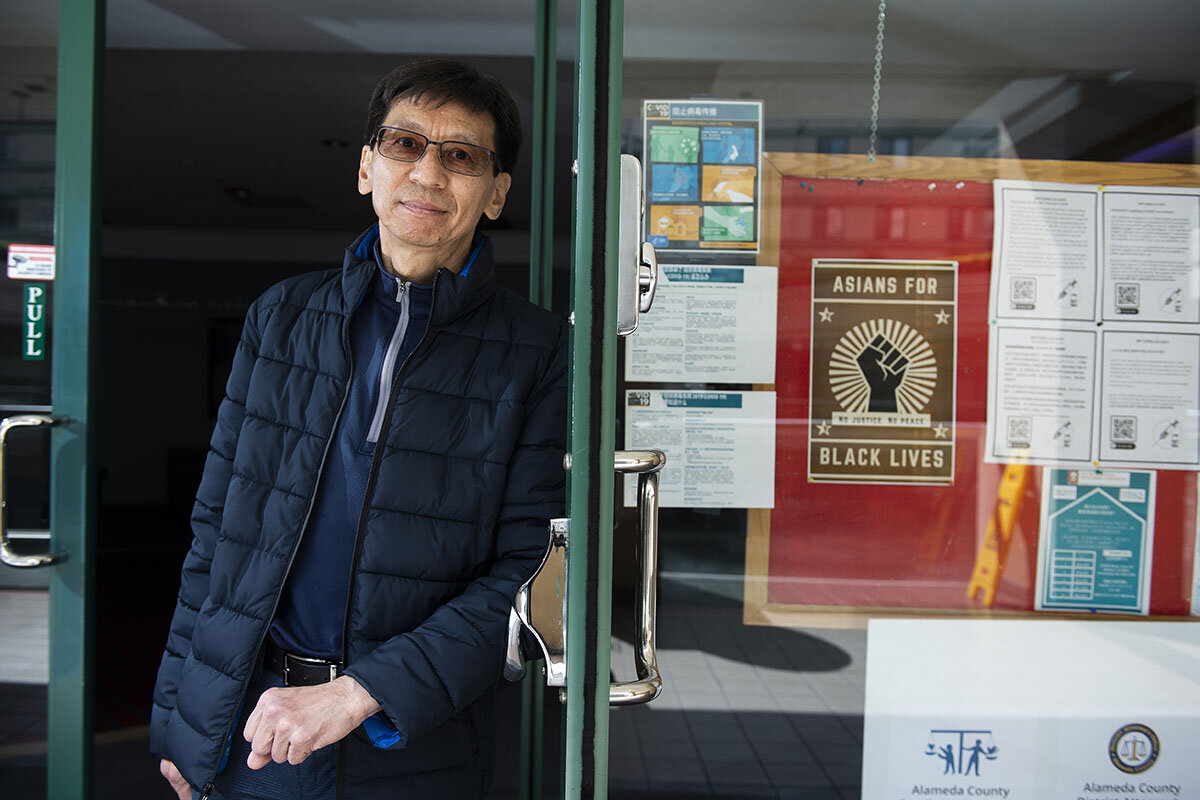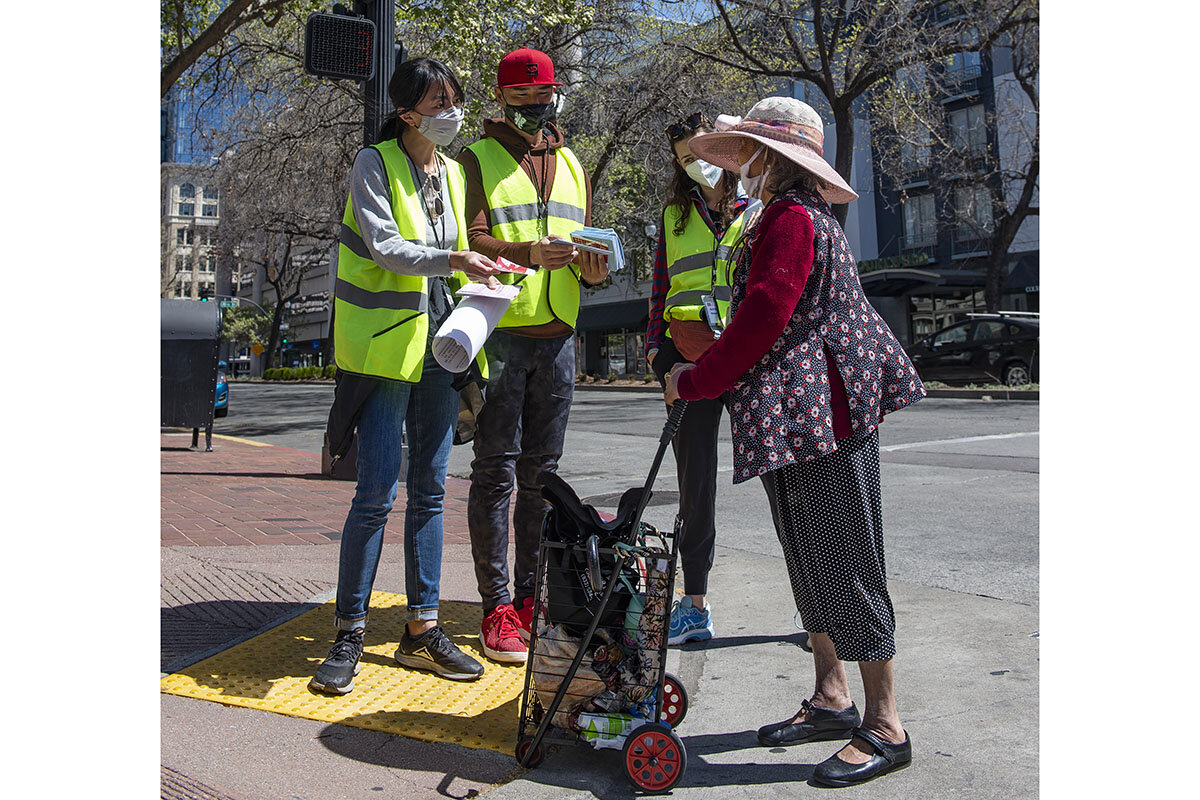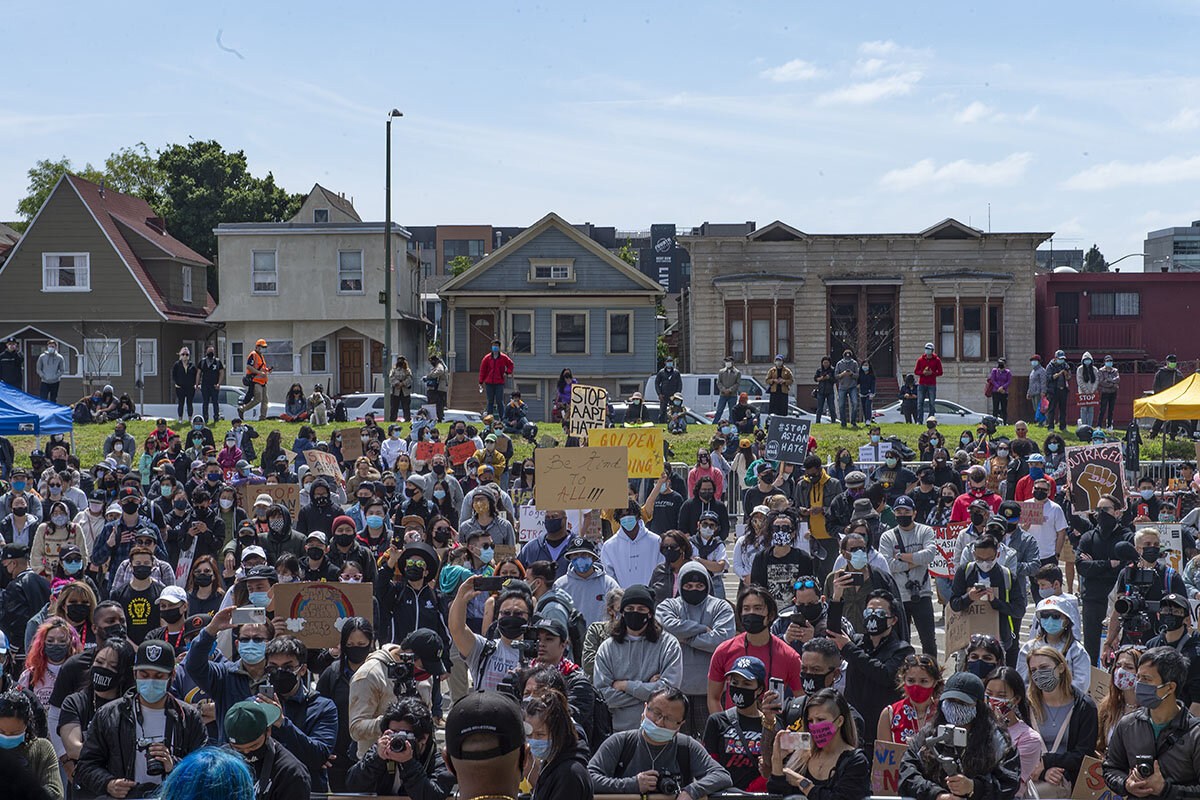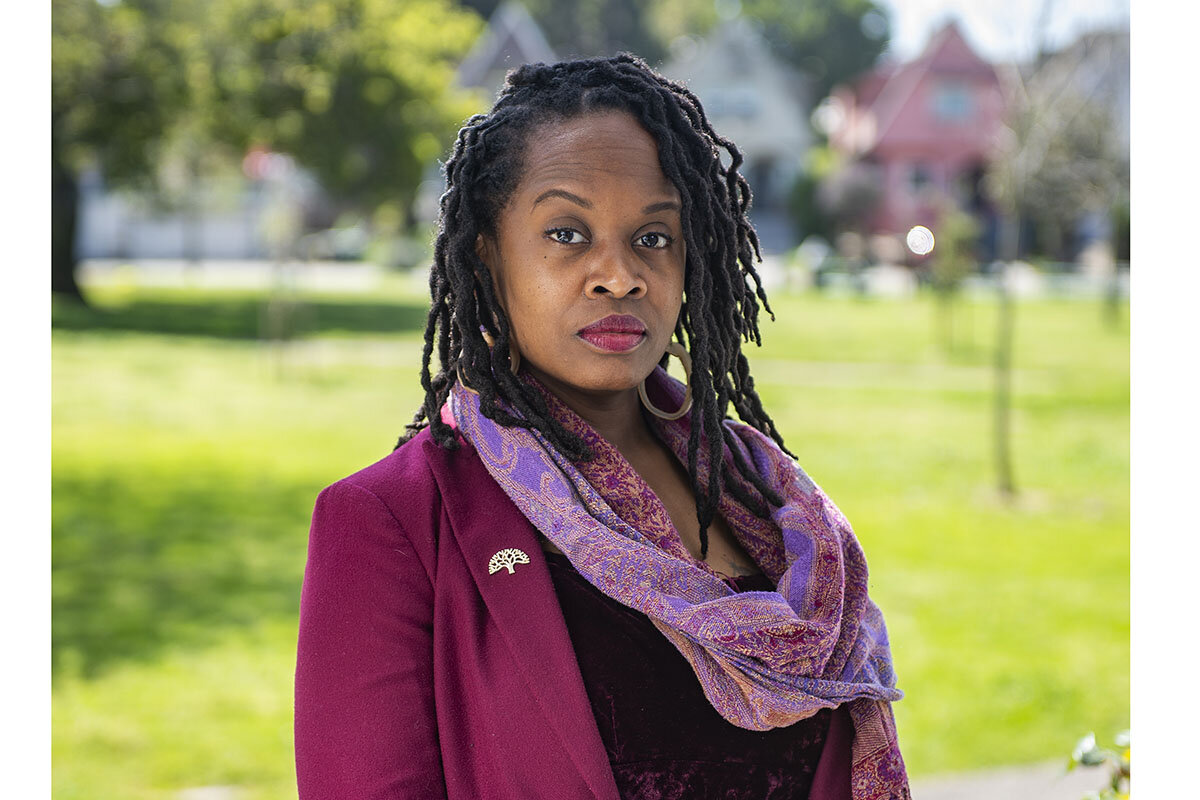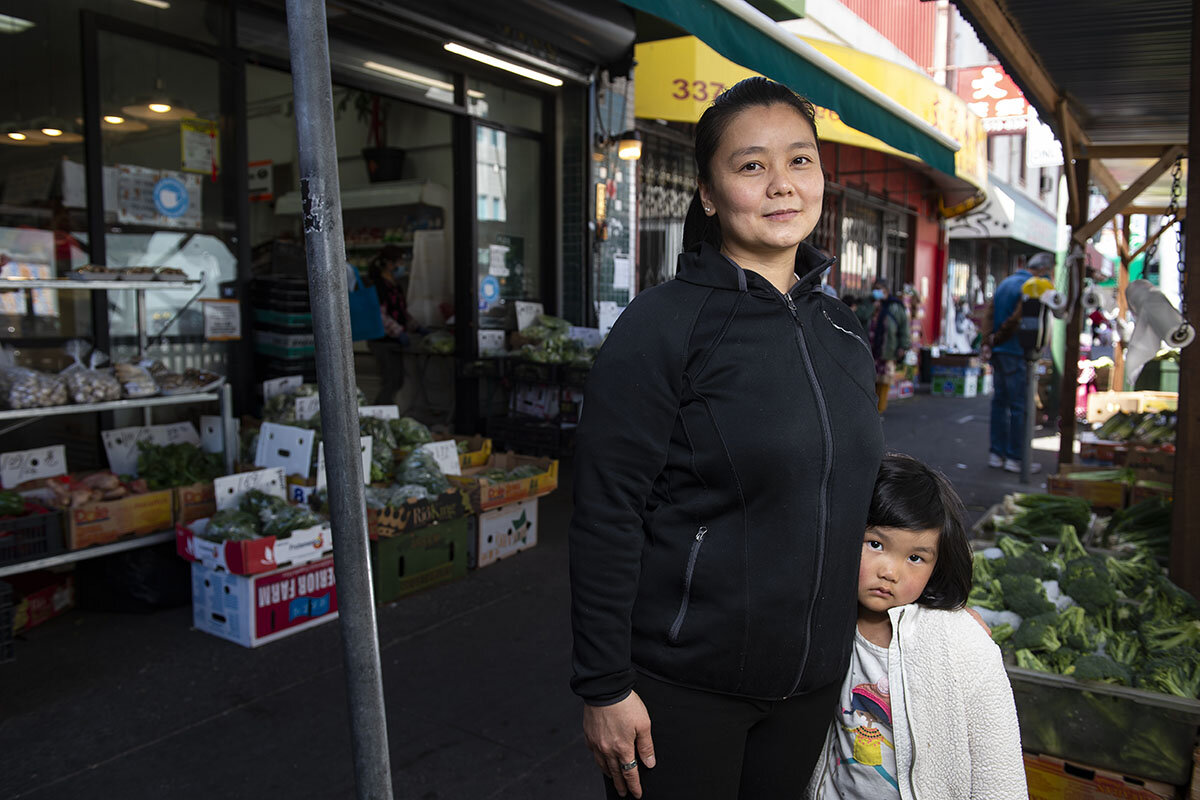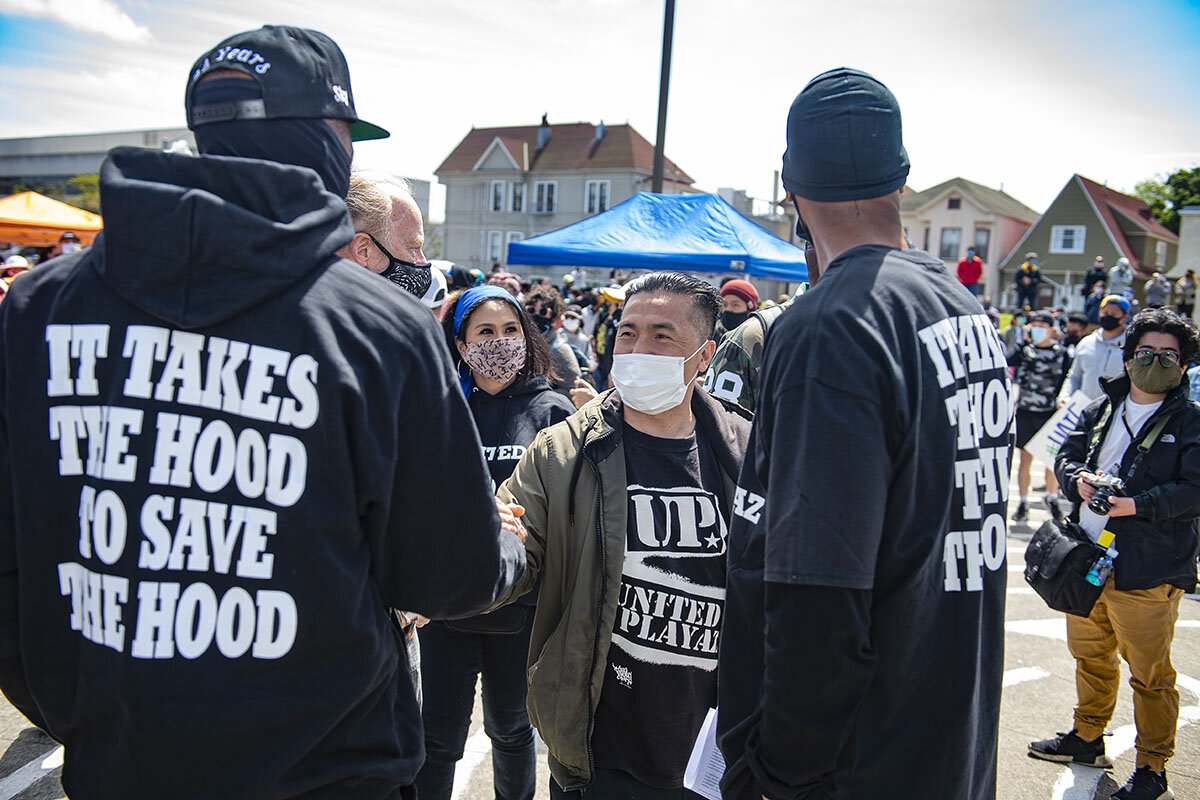How one Chinatown curbs anti-Asian violence and unites a city
Loading...
| Oakland, Calif.
It’s another sunny Saturday in Oakland’s Chinatown, and Jessica Owyoung is addressing a volunteer foot patrol. Pay special attention to people at banks and bus stops, she says, as well as elderly pedestrians who may be slowly crossing the street. They are easy targets. Watch for suspicious vehicles that may be circling. Talk to business owners. Remember to distribute the multilingual booklets on how to report a hate crime. And maybe buy a boba (bubble tea) or lunch to support Chinatown eateries.
She asks for a show of hands on various issues from the more than 20 young people outfitted with neon-yellow safety vests. About half of them, from different racial backgrounds and ethnicities, are first-time volunteers. Four speak Cantonese, the predominant language of this city’s Chinatown. Three speak Mandarin. That’s great – enough to cover each group as they split up and begin patrolling the streets.
“Asian culture doesn’t show a lot of external appreciation,” Ms. Owyoung, one of the co-founders of Compassion in Oakland, a new service to chaperone older adults – or anyone else who feels vulnerable in this enclave – tells them. “Even if you can’t communicate, know that you are appreciated.”
Why We Wrote This
Volunteers from different racial backgrounds and ethnicities are walking the streets of Oakland’s Chinatown to help stem hate crimes. The effort is building racial unity and stirring an “awakening” in the Asian American community.
The teams of chaperones are indeed making a difference, confirm merchants and residents, who are astounded at the unprecedented outpouring of help and media attention being shown the Asian American community after videos of violence went viral early in the year. No fewer than 14 groups are patrolling the city’s Chinatown district – residents and outsiders, Asian, Black, Latino, and white volunteers coming together to fight anti-Asian hate here and across the nation. It’s a show of unity in cities up and down California, which has the largest population of Asian Americans and Pacific Islanders in the country. In the process, racial bridges are being built and a rising generation of AAPI are finding their voice in a movement – some say an awakening – unparalleled among Asians in America.
“This [violence] is the worst we have ever seen, but it’s the best response I’ve ever seen myself, because when the worst came, we are seeing the best of humanity,” says Carl Chan, president of Oakland’s Chinatown Chamber of Commerce, who emigrated from Hong Kong in the 1970s.
Not only volunteers – including the chamber’s blue-vest squads, who patrol seven days a week – but also fundraising. A GoFundMe effort pays for private, armed security guards on street corners and outside businesses. A campaign to buy security cameras is gathering momentum. The Oakland Police Department has reinstated Mae Phu as a community liaison officer after budget cuts eliminated her post. She speaks Cantonese and encourages a hesitant population to report crimes. “Goodness [is] coming out from everywhere,” says Mr. Chan.
But he cautions that it’s not enough to have TV cameras show up and everyone declare victory.
Indeed, there are other narratives. More nuanced ones. About Black and Asian communities, so often pitted against each other, now working together – but also exposing a split with Oakland’s mayor over police funding, a debate far from unique to this city. There’s the story about the complexities of hate crimes and incidents against the AAPI community, and how extensive they are. And there are personal accounts of what motivates this new generation of Asian activists and what they hope to achieve as part of one of America’s most diverse – and misunderstood – multicultural communities.
A community on edge
Chinatown here sprawls across a flat, eight-block area wedged between downtown Oakland and an elevated freeway. One of America’s oldest Chinese enclaves, it was forcibly relocated from another part of town in the 1870s and grew rapidly after the 1906 earthquake destroyed San Francisco’s Chinatown. Thousands resettled here.
Today, it is home to about 3,000 people, many of them older people who emigrated from places like Hong Kong and Vietnam, though more young people are moving in. Men play cards for money in the park, and grandmothers treat their grandchildren to custard buns. Boxes of bok choy and melon sit stacked on sidewalks, roast duck hangs in butcher shops, and seafood markets display orange rock fish on ice and razor clams in saltwater tanks.
But it’s a community on edge and bears the marks of a fraught year: businesses boarded up from last summer’s looting in the wake of the George Floyd killing in Minneapolis, many of the storefronts featuring striking murals of Asian and Black unity. Foot traffic is coming back to the commercial center but is sparse on side streets.
Compassion in Oakland was formed after Jacob Azevedo, a young Latino man, saw two videos of unprovoked attacks on older men in the Bay Area. One showed an 84-year-old Thai American being fatally shoved to the pavement across the bay in San Francisco.
Mr. Azevedo offered in an Instagram post to escort anyone in Oakland’s Chinatown who felt unsafe. Others saw the message and wanted to help – first hundreds and now more than 2,000 people. Among them were Ms. Owyoung and three others who now run the group, which launched in February. They didn’t know each other but had experience organizing volunteers and managing events. Now they’re working to take their initiative to cities across the country.
“I was devastated by what’s happening to elderly Asians in our community. It spoke to me,” says Ms. Owyoung, whose family has spanned 70 years in and around Oakland’s Chinatown. Standing at the entrance to the Pacific Renaissance Plaza, whose fountain is the focal point of Chinatown, she points toward where her grandparents used to operate a sewing factory and all the family helped, including the grandchildren.
She gestures across the street to Asian Health Services, a bedrock service for this community where the median household income is $26,353. It used to be a banquet hall. Her parents got married there. This neighborhood is where she came on weekends, to celebrate birthdays, and to usher in the Lunar New Year.
She, too, has been horrified by videos from security cameras of older Asians being viciously attacked. One in particular, of a 91-year-old man shoved to the sidewalk from behind just a few blocks from where Ms. Owyoung is standing, speaks to the complexity of ethnically based hate crimes. It has had millions of views. It prompted actors Daniel Wu and Daniel Dae Kim to offer a $25,000 reward for information that led to the arrest of the person who did it. As it turns out, the victim was Latino; the suspect who shoved him was a homeless man with a history of random assaults and mental health issues.
A hate crime is typically a violent act committed with a prejudiced motive, by a person who selects victims based on their identity – including race. But that’s not always easy to determine. At the time that activists and volunteers stepped up their mobilizing in Oakland’s Chinatown, the Lunar New Year was approaching. That’s when the older generation is known to carry cash gifts in red envelopes for the younger generation. Are assaults, robberies, and muggings of Asian residents in Chinatown at that time, or at any time, hate crimes? Or are they crimes of opportunity against vulnerable people in a neighborhood where 40% of the population is over age 65?
“It’s not just regular crime. This is hate crime for sure,” says Terin Coleman, a formidable-looking security guard and former police officer, standing on the corner of a boarded-up business. “You don’t see random targeting of the elderly in other neighborhoods.” He co-owns the Goliath Protection Group, which is on a three-month contract to bolster security in the neighborhood, paid for by the GoFundMe campaign. Most of the guards carry handguns, batons, pepper spray, and handcuffs. “Thankfully, it’s gotten a lot quieter here,” he says.
Statistics give an incomplete picture of hate crimes and incidents against Asians and Pacific Islanders. Early last year, activists and experts began to notice a spike in attacks. They attributed it to the pandemic originating in China and fueled by rhetoric from President Donald Trump and other politicians, who repeatedly referred to COVID-19 as the “China virus,” among other names. Mr. Chan explains that Asian residents who have experience with viruses from the region began masking up earlier than everyone else – and that this mistakenly set them apart. Others saw them as sick rather than as people just trying to protect themselves. It also made them an easy target for general outrage against China.
One group, Stop AAPI Hate, formed to collect reports of attacks and abuse against Asian Americans and Pacific Islanders around the nation. Between March 19 of last year and Feb. 28, it recorded nearly 3,800 such incidents – about 11% of them physical assaults. Because this is a new collection effort, there is no way to compare it with previous years.
A large percentage increase, however, has been reported by the Center for the Study of Hate and Extremism at California State University, San Bernardino. Earlier this year it revealed that hate crimes against Asian Americans in 16 major cities shot up by nearly 150% in 2020, compared with the year before. But the actual number of incidents remains small: six cases in San Francisco increasing to nine; seven cases in Los Angeles rising to 15; and, in the greatest jump, three cases in New York increasing to 33.
Yet activists maintain that this tally of violence and harassment against Asian communities is just the “tip of the iceberg.” Indeed, Congress is moving toward passing bipartisan legislation to beef up the federal response to hate crimes against AAPI. Experts say the actual level of hate crimes and incidents is partly hidden by the “myth of the model minority,” the assumption that all Asians are successful, highly educated, and wealthy. In Oakland’s Chinatown, nearly a third of the population lives below the poverty line, according to the U.S. census. Only 30% have a bachelor’s degree or higher, and the vast majority speak a language other than English at home.
Ask if someone has encountered racism, and most everyone has a story to tell.
Safer, but still scared
At a rally in Renaissance Plaza, Wendy is in tears as she describes being robbed three times in one month and being called “China virus.” She is not a native English speaker and her comments are translated by Mr. Chan, who gently pats her back as she’s overcome with emotion. Now she volunteers with the blue vests.
Volunteers with Compassion in Oakland talk regularly with older residents, who tell of being harassed, particularly on buses. One woman’s phone was stolen after she got off a bus. Others say they won’t take mass transit to Chinatown at all anymore. They have their children drive them.
Even so, Finnie Phung, who runs the Green Fish Seafood Market with her husband, Eric, says she’s never seen the community pull together so strongly. People are communicating and sharing intelligence on the WeChat app. As she unloads crates of produce, she stops to say she’s happy to have the volunteers, but laments that it’s not possible to station them on every corner. She now looks over her shoulder when she’s on the street. And she emphatically answers “oh yeah” when asked if crime and racism have increased since the pandemic started.
She recounts one incident at a bank where a Black man yelled at her to go back to China and then went on a racist rant. Her teller explained that this customer does that a lot and that it’s OK. “I was shocked,” she says. At the man. At the teller. “It’s not OK.”
Ms. Phung has bought her employees personal alarms and asked them to walk in groups. They now wait for each other at quitting time. Two of her employees, she says, have been attacked with knives. The retired husband of one of her workers got pinned down and robbed. This is not new, she says. It happened to her mother 40 years ago, and to her aunt 20 years ago. What’s new are the media and videos from surveillance cameras bringing everything to light, she says.
Ms. Phu, the liaison officer with the police department, says that statistically the level of crime in Chinatown is about the same compared with before the pandemic. But the crimes, she says, have become more violent and more often target older adults. Both hate crimes and crimes of opportunity are occurring, she says, “but we also know that the Asian community doesn’t usually make a lot of police reports. ... That’s been a problem.”
Language barriers are an issue, but so is the culture. People share information with each other, but not with officials. Mr. Chan, also known as “the mayor of Chinatown,” says people come to him with reports of hate crimes and other abuse. He’s seen a real surge over the past year. He worked with the Alameda County District Attorney’s Office to make it easier for the community to report hate crimes. But when it comes to confirming names and addresses, most people decline, and their cases don’t make the official count or get acted on. “The number being [officially] reported is way less than 20%,” he says.
Still, he believes Chinatown is safer now, and says volunteers have prevented many incidents. They hand out air horns and teach merchants how to use them if they are robbed. Volunteers then race to the scene and alert police. The volunteers have become the eyes and ears of law enforcement.
Whether people actually feel safer is another matter. One older gentleman, Yau Yuk Shek, who is reading a newspaper in Renaissance Plaza, says that “of course, definitely” he feels more secure with all the patrols around. Indeed, a swarm of orange-vested volunteers hovers nearby. But others don’t feel so sanguine. They still say: We’re scared.
Asian-Black unity is not new
Kinyatta George is a frequent volunteer with Compassion in Oakland. The tall, young African American man is eager to help by waiting for people outside banks, sometimes engaging in long talks with merchants and just being a reassuring presence. He’s also an example of Black-Asian unity, which is helping to counter the narrative of enmity between the two communities.
“I can feel some of the old people being uncomfortable,” says Mr. George, who grew up in neighboring Berkeley and just started work as an X-ray technician at San Francisco Airport. “But once I show them a friendly persona, the prejudice drops.” Some of the highly publicized cases of assaults in the Bay Area and elsewhere have involved African American suspects, says David Lee, executive director of the Chinese American Voter Education Committee. “People are sensitive, myself included, of this being used as a wedge issue between African Americans and Asians.”
He cites the 1992 riots in the Los Angeles section of Koreatown after the acquittal of law enforcement officers in the beating of Rodney King, an African American. Tension and violence had been simmering between the two groups, and the media stoked those flames of rivalry and friction, he says.
What’s “remarkable about Oakland,” observes Mr. Lee, is that just after the incident of the man being shoved to the pavement, African American and Asian leaders organized a unity rally just blocks away. “Some of the loudest voices supporting Asian Americans have come from the Black community in Oakland,” he says.
That’s no surprise, says Carroll Fife, a longtime social justice advocate newly elected to the Oakland City Council. She describes this progressive city as one of the most diverse in America, with a long history of Black-Asian unity. She dates the cooperation back to the era of the Black Panther Party, which was founded in Oakland and included among its leaders a Japanese American activist, Richard Aoki. Decades of intercommunity work followed.
“We’ve had Asians for Black lives. It stands to reason we’d have Blacks for Asian lives,” she says.
And yet cracks have appeared: resentment from other neighborhoods that Chinatown has gotten so much attention; generational differences between Asian parents and their children over police funding and the role of police; and a political split.
Earlier this year, police funding caused a public rift between the mayor, and City Council members Fife and Council President Nikki Fortunato Bas, a representative for Chinatown. Since then, the City Council voted unanimously with the mayor to restore citywide funding to police and other community services that had been cut. Larger issues about policing, though, remain unresolved, with a task force on re-imagining public safety readying its final recommendations as the city nears a budget deadline for the next two years.
“A multicultural poster”
Ms. Owyoung of Compassion in Oakland steers clear of politics. She’s too concerned about making the most of the current momentum and building out the organization, even though the founders all have day jobs (hers is as a counselor of students with disabilities).
“Our No. 1 challenge is time,” she says. “We know that we have to move quickly because we don’t know how long this momentum is going to last.” While Black and Latino communities each have “solidarity,” she notes, “There’s never been this huge of a movement and focus only on Asian Americans.”
Up to now, Asians have been taught to just accept racist acts in order to move forward in America, the volunteer leader notes. Historically, the Chinese Exclusion Act of 1882 banned Chinese laborers from coming to the United States. Although the act was repealed in 1943, Chinese immigrants were restricted until 1965, when the National Origins Formula was abolished. Japanese Americans were interned in camps during World War II.
Ms. Owyoung’s grandmother was not allowed to live outside Chinatown in San Francisco, and when the family moved to Oakland, it was prohibited from buying property in certain areas.
What’s most gratifying about her work now is seeing so many volunteers from so many backgrounds showing that they care. “I’m going to cry” – she pauses for a second – “just seeing them build relationships and getting to know each other.” The other day, she saw a white person, African American, and Asian in one of her volunteer pods exchange phone numbers after their shift and then grab something to eat. They were like “a multicultural poster.”
In the foot-patrol teams, the cross-pollination is evident. Walking along the streets, Christina Chen, a lawyer in San Francisco, acts almost as a docent to the other pod members: That parking lot is where she played as a child; that’s where her parents have their acupuncture practice (both have been robbed); the murals are to cover up graffiti. At the end of their shift, Justin Zerber, who is white, comments how much more aware he is now that he’s walked in a different community.
In another group two Asian Americans share their experiences. Hochi Manglapus, from behind round blue sunglasses, says he felt “a bit invisible” growing up in a white neighborhood. A first-time volunteer, he now feels like he’s part of an “awakening” of Asians who, instead of trying to fit in, are finding their own voice.
Cami Louie, her dog tugging at a leash, says most of her friends are Black and Latino. The nursing student is now patrolling the streets that her grandparents walked. To her, it is more than a movement. It’s standing up for yourself. “I’ll be doing that as long as I live,” she says.
Still, she wonders what the impact of the volunteers will really be. “I don’t know if us being out there is doing anything. People still have their prejudices.”
True. But certainly not among the chaperones here.
• Halton Suen was an interpreter for this report.




